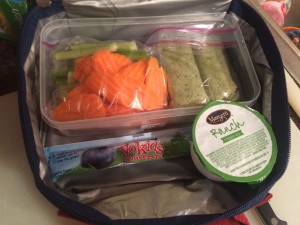by Heather Kent | Oct 1, 2015

4-H began with agriculture in 1902 and over the past 100 years has grown to help youth learn about everything from agriculture to aerospace.
4-H began with the seed of an idea. In 1902, America needed folks to embrace new advances in agriculture. But leaders with open minds, strong hearts and willing hands weren’t in abundance. Luckily, kids were. By empowering the next generation to lead, 4-H took root, and grew. 4-H grew kids who are confident and strong; who are curious enough to question and capable enough to find the answer. We grew kids who stick to a job until the job gets done; who know how to work with others and most importantly, how to lead.
Over the century, 4-H has kept right on growing. We grew out of the farms and into the towns, suburbs, and cities. Today, 4-H exists anywhere curiosity roams and confidence thrives; anywhere technology can be advanced and achievement is valued. 4-H is anywhere positive change is possible and giving back moves entire communities forward.
When you think about it, it makes perfect sense that we began with farming. After all, true leaders aren’t born- they’re grown. Next week (October 4th-10th) marks National 4-H Week. This year, to celebrate, our blog will highlight how 4-H is growing Confidence, Curiosity, Compassion, Character, and Responsibility by sharing the stories of real Florida panhandle 4-H members, volunteers, and alumni. We hope that you will enjoy this series and that you will be inspired to make a difference in your community by sharing your skills, talents, and passions with other 4-H youth and volunteers. We hope you are inspired to cultivate 4-H so that it can keep right on growing for the next 100 years! For more information about 4-H, visit http://florida4h.org or contact your local UF IFAS County Extension Office.
by Heather Kent | Sep 25, 2015

4-H Projects are about developing blue ribbon youth rather than blue ribbon projects.
Make a Difference Monday, our online volunteer training series, kicked off this past Monday night! This year’s series focuses on helping youth develop a sense of Mastery, one of the Essential Elements of a positive youth development. Mastery is all about building knowledge and skills and being able to demonstrate those skills and knowledge effectively. Mastery is developed over time through intentional 4-H project work, events and activities. The main goal of the 4-H Project is to help youth develop life skills, regardless of the subject matter content. Some of the important components of a project include:
- The use of quality educational materials to guide youth through a planned sequence of learning activities (4-H curriculum and project guides)
- Project work is guided and validated by supportive, trained, caring adult project mentors or leaders (4-H project leaders and resource leaders)
- Youth have opportunities to share what they have learned with others through club or county demonstrations, exhibits, shows, and other contests. (Hint: tune in October 19th for an overview of 4-H events and activities and how they can support the project work of your club members)
- Provide youth with opportunities to self-evaluate and gain a sense of accomplishment through project reports and the Florida 4-H awards and recognition model (Hint: tune in November 16th for an overview of our awards and recognition system and how project reports can help members with their portfolios for scholarships).
Here are some additional resources about 4-H projects, and how to use experiential learning to help develop life skills through 4-H project work:
In case you missed our live session, it was recorded and can be viewed online at http://florida4h.org/.madmondays. You can also check out our entire series schedule and find out how to connect from the comfort of your own home. We hope to “see you” online in October as we work together to “Make the best better!”
by Whitney Cherry | Sep 25, 2015
 My husband calls me the one-trip-wonder because of my stubborn refusal to make more than one trip in from the car regardless of the size or number of items needing to be carried in. I know he thinks I’m crazy, but really, who has time to make 27 trips from the car to the house? I guess it’s that same “who has time for this?” mentality that has also caused my friends to deem me the one-pot-wonder. Truly, if I can get it all in one pan, that’s less dishes I took the time to dig out, and certainly less to wash and put back. Love it!
My husband calls me the one-trip-wonder because of my stubborn refusal to make more than one trip in from the car regardless of the size or number of items needing to be carried in. I know he thinks I’m crazy, but really, who has time to make 27 trips from the car to the house? I guess it’s that same “who has time for this?” mentality that has also caused my friends to deem me the one-pot-wonder. Truly, if I can get it all in one pan, that’s less dishes I took the time to dig out, and certainly less to wash and put back. Love it!
So, perhaps that’s why I feel uniquely qualified to share a few recipes with you that should help you manage your time in the kitchen during this hectic time of year. Don’t worry. These are not one-pot-wonder recipes. You will need to dig out an extra pot or two for veggies – canned, fresh, frozen – you’re choice. But even with the extra dishes, the time these recipes save at the grocery and in the kitchen will totally be worth it.
- Clam Linguine: I feed this to kids and they love it. Ingredients can be kept on hand at all times, so it’s great for the “no time to hit the store” weeks.
- Macaroni and Cheese Casserole: Another kid favorite. Brown the burger and throw it in the freezer in portioned out Ziploc bags. Now you have another dish on hand with ingredients that are always accessible.
- Shell Macaroni Casserole: Again, kid approved. Given your already browned burger is frozen in the fridge, you’re golden for a night without stopping at the grocery AGAIN!
- Crockpot Stroganoff: Easy peasy, but may require a grocery run if you don’t have some items frozen already.
- Chicken Quesadillas: Another easy one to keep all ingredients on-hand. And… you guessed it: Kid favorite.
Bonus recipes: Great for potlucks, parties, and guests.
Printer Friendly Version: All Recipes Included
I hope you enjoy these recipes and their accompanying time-saving tips. But my greatest advice to you is to think of the dishes your family loves most and look for faster or easier ways to make them on busy nights. I don’t really cook like this all the time, but there are nights when I’m moving so fast I could leave Rachel Ray in the dust. When you have to, do it and don’t feel guilty. When you don’t, call the kids in and make meal prep a leisurely, family affair. It’s all about the ever-elusive balance we all seem to be looking for. Truthfully, we’re cooking like this because we care about our families. We want them to have hearty meals and time to enjoy them together. Sometimes, getting them turned out a little quicker is all that stands between us and letting that happen. If you have other tips or recipes you’d like to share, please feel free to leave them in the comments.If you have a passion for culinary arts, consider sharing your love with the youth in your community. Contact your local 4-H Extension Agent today, and see how you can help him/her make a difference in the lives of young people.
by Melanie Taylor | Sep 11, 2015

Packing the kids’ lunches for school means you know which nutritious foods they are eating. Here are some budget-friendly, creative ideas to keep kids happy and healthy at lunchtime.
Make a “Smarter” Sandwich:
While some kids prefer the same thing every day, others may be okay with a slight switch to their sandwich.
- Use different breads like 100% whole wheat tortilla wraps (choose wraps low in saturated and made with no hydrogenated oils) or 100% whole wheat pita pockets.
- Besides lettuce, try shredded carrots or avocado slices with a turkey sandwich.
- Buy blocks of low fat, low-sodium cheeses. You save money when you slice it yourself. Or use a cookie cutter to cut into fun shapes.
- Instead of lunch meat, try a leftover grilled chicken sandwich with lettuce and tomato.
Love Those Leftovers:
Try using the leftovers from the family dinner for the next day’s lunch. Invest in a thermos to keep foods hot or cold until lunchtime.
- Low-sodium tomato, vegetable or bean soups
- Chili made with lean or extra lean ground turkey
- Whole wheat spaghetti with low sodium tomato sauce
- Low-sodium baked beans, bean casserole or beans & rice
Let Them Dunk:
Sometimes it is okay to let your kids play with their food, especially when they are getting extra nutrition.
- Apple and pear slices to dip into low-fat plain yogurt mixed with peanut butter.
- Carrot, celery and sweet pepper strips to dip into hummus, fresh salsa or homemade bean dip.
- Whole grain crackers (choose crackers low in sodium and saturated fat and made without hydrogenated oils) to dunk into low-sodium vegetable or tomato soup.
- Unsalted sunflower seeds, crushed whole wheat cereal and sliced banana to mix into low fat vanilla yogurt (no added sugars) to eat with a spoon like a sundae.
Get Them Involved:
While letting kids in the kitchen might mean a bigger mess, if they help pack their own lunch, they are more likely to eat it! On nights you have a bit more time, like a Sunday night, have them choose which piece of fruit or what type of whole grain bread they want and let them assemble their lunch. Make this a weekly routine – it’s another great way to spend family time together.
For more heart healthy lunch tips visit: www.heart.org
by Prudence Caskey | Sep 5, 2015
Who doesn’t want a little more time? I am always looking for ways to help me get more done in the time I have. Over the years, I have found some great applications that I would like to share with busy 4-H parents and volunteers:
- ANYLIST—this is a great application allowing you to create lists. I have a list I have named, “My Grocery List.” The neat thing about it is when I say to Suri, “add milk to my grocery list,” she does it! It makes it easy to compile a grocery list and I don’t even have to find a piece of paper.
- MY FITNESSPAL—this application allows you to log everything you eat and helps you stay accountable. It will also talk to your exercise tracker to offset the amount of calories you can eat versus the calories your burn each day. The BODY TRACKER application can keep track of body measurements and how much muscle you gain and how much fat you lose.
- COUNTDOWN—this application allows you to enter upcoming events from your calendar and keep track of how many weeks, days, hours, minutes and even seconds to deadlines! This allows you to prioritize based on what is due next, whether it be birthday shopping, a 4-H club meeting, or homework assignments.
It can be daunting for parents to keep track of work, family, church, sports, and school calendars. Sharing calendars can help see where everyone is at a glance. There are many applications that are free to help you get organized and save time- these are just a few great examples. Remember, not every application is for everyone. If I find that an application just doesn’t work for me, then I erase it. We all have different opinions on which applications will work best. For instance, my husband likes Weather Channel but I prefer AccuWeather. We both get the weather, just through different applications. Check out some of these applications to save time and stay organized this 4-H year!
by Whitney Cherry | Aug 28, 2015
 Research shows that 20-40% of children are bullied in some way. Whether bullying is verbal, physical, or done online it is a very real problem that can happen in any school, even among young school-age children. A safe and secure environment is key for the Essential Element of Belonging, one of the foundations of 4-H positive youth development. Being educated about what bullying is, knowing how to spot the signs of bullying, and learning what to do if your child is affected by this behavior can help parents address bullying if and when it happens.
Research shows that 20-40% of children are bullied in some way. Whether bullying is verbal, physical, or done online it is a very real problem that can happen in any school, even among young school-age children. A safe and secure environment is key for the Essential Element of Belonging, one of the foundations of 4-H positive youth development. Being educated about what bullying is, knowing how to spot the signs of bullying, and learning what to do if your child is affected by this behavior can help parents address bullying if and when it happens.
How to recognize bullying- Bullying can take several forms. It can be observable or secretive behavior.
| Observable Behavior: |
Secretive Behavior: |
- Intimidation and threats.
- Name calling, insults, and comments about disability, gender, and race.
- Teasing about personal characteristics or sexual harassment.
- Physical assault, tripping, hitting, pinching and other physical abuse.
- Destruction of property, demanding money or other possessions.
|
- Rejecting, excluding, and isolating victims from others.
- Spreading rumors and other public humiliation.
- Manipulating friends and relationships, passive aggression.
- Passing damaging notes or posting threatening or damaging emails or web material.
- Blackmailing, harassment, and dangerous dares.
|
Left unaddressed, bullying can cause depression and lasting psychological damage to the victim. It can result in poor attendance or psychosomatic illnesses. Violence can escalate into serious property damage, and injuries to students and adults. Bullying at school also affects others who are not involved directly but who simply witness or are aware of mistreatment of another student. These students may suffer from fear and concern about their schoolmate who is targeted. They may feel guilt but also may fear the bully so much that they do nothing to help. Worse, they may become offenders themselves because they fear the perpetrator will target them.
Bullies tend to seek out victims who:
- Are unable to defend themselves.
- Have little social support, or few friends.
- Are not involved in extra-curricular activities.
- Are low achievers in academics or sports.
- Are not popular or focused on by adults in the school.
- Have less developed social skills.
- Have difficulty communicating.
- Have low-self esteem or are unassertive.
Know the warning signs of bullying- It is not uncommon for a child who may be the victim of school bullying to be reluctant to tell his or her parents out of shame or fear. Children fear that the adults will not be able to help them or that they may make the situation worse. They may also believe the bully will retaliate against them or their friends. If you suspect that your child may be a target of school bullying, look for these signs:
- Sadness, anxiety, difficulty sleeping or eating, temper or emotional outbursts, picking on younger siblings.
- Unexplained bruises, cuts, or damaged clothing or school supplies.
- Fear of school, not wanting to go to school, or sudden drop in school performance.
- Dislike of recess and avoidance of unsupervised school areas such as the bathroom, despite the need to go.
- Withdrawal from friends and family, fear of parent communication with teachers.
- Complaints of physical problems without a medical reason.
- Any abrupt behavior change or sudden lack of self-esteem.
What Parents Can Do to Prevent and Stop Bullying –Parents are the key to preventing and stopping bullying. Here are a few ways that parents can help respond to bullying.
Stay connected with your child. The more you know about your child’s friends and their interactions with classmates and peers, the more likely you are to spot any changes in their social circle. Talk with your child every day about specifics at school and extracurricular activities such as what the best or worst part of their day was. This is also an important way to establish good communication with your child so that they can come to you when they have a problem.
Explain to your child what bullying is. Children understand that hitting or pushing another child is wrong, but you can also explain that other forms of bullying, such as excluding or ignoring someone, can also be hurtful.
Tell children what to do in case they experience or witnesses bullying. Talk with your child about the basics of what to do if they encounter hurtful behavior directed toward them or someone else. Tell your child to alert a teacher right away if they see or are subject to bullying behavior, and that it is important to stop someone from getting hurt.
Teach a child the importance of empathy. Research has shown that emotional intelligence and empathy skills may be even more important for success in life than intellectual intelligence. A child who is able to understand what it may feel like to be bullied and can understand and regulate their own emotions is less likely to engage in that kind of behavior.
Set a good example. Do you ever make fun of other people or gossip about others in front of your child? Have you ever spoken rudely to a waiter at a restaurant or to a store clerk in a shop? Even if you think your children are not listening or observing your behavior, the fact is that kids learn a lot about how to conduct themselves from watching their parents.
Talk to your school about what programs are being used to deter bullying. If you suspect that your child may be the victim of school bullying, talk to your child’s teacher about your concerns. Ask the teacher to watch out for problems and notify the school principal and counselor about your concerns as well.
As parents and volunteers, it’s our job to provide youth with a safe environment where they can learn and grow. For more resources about bullying, contact your local UF IFAS Extension Office, or download some of our other resources:
Talking About Bullying
Bullying and Children with Disabilities
Bullying Related to Lack of Time with Dad
Cyberbullying
Outcomes of Bullying
Parent’s Role in Bullying Behavior
Teens and Sexual Harassment: Making a Difference
by Heather Kent | Aug 21, 2015

4-H embryology is a great way for school youth to learn about STEM and agriculture
For more than 100 years, 4-H clubs have been (and still are) the backbone of our youth development program. But did you know that 4-H also provides opportunities for youth to participate in programs during and after school? Not all youth have access to transportation to and from club meetings. 4-H school programs are a great way for those youth to glean the benefits of 4-H and to learn about other opportunities to be involved longer term.
Some examples of 4-H School programs offered in the 4-H Panhandle include:
Sometimes school programs such as 4-H Embryology or 4-H Tropicana Public Speaking are taught by teachers, using 4-H curriculum and resources with support from the 4-H Extension Agent. Other programs are coordinated with a team of volunteers and 4-H staff (such as 4-H Ag Awareness or Ag Literacy Week). County Extension offices offer training, curriculum, and equipment for teachers and volunteers interested in leading 4-H programs at local schools. In addition, these programs receive support from extension agents and UF IFAS specialists with subject matter expertise, so you can be sure that youth are receiving the most up to date, non-biased information available.
If you have skills that you would like to share with the next generation, consider partnering with your local school and 4-H program. To find out which opportunities are available in your area, contact your local UF IFAS County Extension Office or visit http://florida4h.org/volunteers.
by Melanie Taylor | Aug 15, 2015
 As summer break comes to a close, many children will be experiencing changes in their school experience at an entirely new school. Be sure to make the transition as easy as possible by talking with your child about the positive experiences they may have this new school year. Below are a few tips on how to help you and your child adjust to such a big change with the least amount of stress.
As summer break comes to a close, many children will be experiencing changes in their school experience at an entirely new school. Be sure to make the transition as easy as possible by talking with your child about the positive experiences they may have this new school year. Below are a few tips on how to help you and your child adjust to such a big change with the least amount of stress.
Introduce yourselves to the new school:
• Make sure that the new school expects you: register your child before the first day of class
• If possible, visit your child’s new school: try to meet the office staff, principal, and teachers before the transition to establish a personal connection and to help them prepare for your child’s arrival
• Some schools have “welcome packets” to give to new families; if not, try to get basic information, such as what time the school day begins and ends, the procedure for lunch (can your child buy lunch, does the school provide snacks, etc.), transportation procedures (what’s the bus schedule), and information about health services and emergency procedures
• Try to meet other school families; if you have an elementary school-aged child, see if you can arrange a “play date” with another child in the same grade (preferably before the first day of school.)
• Become involved in your child’s new school. Consider joining the PTA, or volunteering at the school; the more involved you are, the more your child will feel like his or her school is important to you and the more connected he or she will feel.
Help your child adjust:
• Make sure your child understands the reasons for changing schools; if you have an older child, try to give him or her as much “advance notice” as possible so that he or she will have time to adjust to the idea
• If time allows, show your child his or her new school and the surrounding neighborhood; see if you can arrange for a student to show your child around the school and introduce him or her to teachers and staff; some schools have a “buddy system” or other ways of helping your child meet other children in the school
• Make sure the school has what it needs to make the best decisions concerning your child’s classroom placement and academic and social needs; confirm that the new school has obtained your child’s educational, health, and other relevant records
• Be patient. It is perfectly normal for a child to feel anxious, scared, or irritable during times of transition. Let your child know that you understand that this is difficult; take the time to listen to his or her concerns, and spend time together while your child develops new school connections and friendships
• Stick to your routine. If rapid changes have left your child upset, knowing what’s expected at home can provide a comforting calmness. Encourage your child to feel good during this stressful time: encourage (or enforce) a schedule including a regular bedtime and a healthy breakfast.
• If your child had a negative experience at his or her last school, speak positively about the fresh opportunity that the new school presents. Help your child develop new goals for school success
• If your child is young, or is particularly nervous, consider accompanying him or her to school for the first few days
• Encourage your child to become involved in school activities, sports, or after school clubs
• Make sure your child has what he or she needs for the first day of school (ask the school for a classroom supply list.) This will make your child feel more included on the first day.
• Help your child identify something good about his or her new school, and offer comfort and reassurance that adjusting to a new school takes time.
One of the most important steps as a parent is to realize that moving to a new school is a very big deal for many children. There may be a few bumps in the road along the way, but remember to be patient, understanding and there for your child and he or she will eventually adjust. This adjustment could take up to 6 weeks. If the adjustment continues to be struggle after several months be sure to consult with a school counselor to help with any further assistance.
Do you have a skill or passion that you would like to teach the next generation? Consider becoming a 4-H volunteer. 4-H offers a wide variety of opportunities for volunteers to make a difference in their community, or even at their school. Next week, our blog post will focus on ways that you can volunteer through 4-H school programs. To find out more about volunteer opportunities, contact your local UF IFAS Extension Office, or visit http://florida4h.org/volunteers.
by Prudence Caskey | Aug 7, 2015

Back to school shopping can be a teachable moment for your kids about money management
In many parts of Florida, school starts in less than a week! Depending on where you live, what school your children attend, and what grade they are in, back to school supplies can cost the average family anywhere from $100 to $500! Keeping this in mind, it is time to start thinking about a strategy for your back to school shopping. The good news is, the back-to-school tax holiday has been extended from three days to ten days this year!
The tax holiday will begin August 7 and run through August 16. Tax-free items include; clothing, footwear, wallets, bags that cost $100 or less, school supplies that cost $15 or less, and the first $750 of the cost of personal computers and related accessories. Now that you know when and what to shop for, here are some tips on how to shop to make the most of every dollar:
Have a plan
- Get the supply list for your child’s school and make notes.
- If you have more than one child, compile a combined list. If your son needs 6 folders and your daughter needs 6 folders, on your list, simply write “12 folders”. This will cut down on the time spent on shopping.
Have a budget
- Make a list of what your children will need and get an idea of how much it will cost.
- Use back to school shopping as an opportunity to help your child learn about prioritizing and budgeting. Tell your child how much they have to spend for specific items. For example, they can spend $20 for a backpack, $50 for shoes and $200 for new clothes. If they want the $90 pair of shoes, they will need to get a less expensive backpack or spend less on clothes. This will help you stay within your budget and aid in teaching your children some financial skills. It is a win-win!
Shop around
- Many stores are having sales right now. If you approach back-to-school shopping like you might do “Black Friday” shopping, you can have a lot of fun with it!
- Check ads in the Sunday paper for sales on items on your list. Many papers will also have coupons for wipes, paper towels, and other items often found on preschool or elementary school lists. You can also use online coupons, e-coupons, and store loyalty cards for even more savings.
- Check out stores you may not have considered in the past such as office supply stores, dollar stores, and even thrift stores.
Plan for next semester
- Now is the time to get all of the supplies you need at a great price. If you find a good deal on some basics, stock up for next semester on items like glue sticks, pens, folders, and notebook paper.
Going back to school can be an expensive time of year; however, it doesn’t have to be with a little planning and budgeting. Put the same energy into back to school shopping that you might do with Christmas shopping. Make it a sport! Remember for next year, at the end of the summer, school is approaching and you can plan for it. If you are interested in financial management, budgeting, or shopping, consider becoming a 4-H volunteer! We need volunteers to share their knowledge and skills with youth to teach youth about financial literacy and consumer choices (smart shopping). If you are interested, contact your local UF IFAS Extension Office, or visit http://florida4h.org./volunteers.
by Melanie Taylor | Jul 31, 2015

Stay hydrated to beat the heat!
Summer is in full swing and our part of the country is very hot. When the temperature rises, proper hydration is extra important. You need to provide your body with the fluid that it needs to stay healthy. Water regulates many different body processes, including body temperature, digestion, and heart rate. It also cushions and protects our internal organs and joints. When we do not get enough of it, our bodies can suffer. We lose water from our bodies every time we breathe, sweat, or urinate. In fact, it’s estimated that you can lose up to 4 cups of water during an hour of exercise in the heat. This water loss can lead to dehydration.
Signs of dehydration include:
- Little or no urine, or dark urine
- Dizziness, or lightheaded feeling
- Dry mouth
- Sleepiness or fatigue
- Extreme thirst
- Rapid breathing
- Rapid pulse
- Headache
- Confusion
- Cramping
Ultimately, dehydration can lead to extreme thirst, confusion, heat stroke, loss of consciousness, and death. So, how can you manage staying hydrated in the heat of summer? One of the key answers is not to wait until you are thirsty. Drink water regularly! Food can also provide some of the water you need every day- especially food like watermelon, soup, milk, lettuce, and strawberries. Sugar-sweetened sports drinks or beverages with added minerals, vitamins, or electrolytes are NOT necessary unless you are a competitive athlete or in heavy training for an athletic event.
Tips for staying hydrated:
- Keep a bottle of water with you during the day. Purchasing bottled water is expensive and creates plastic bottle waste. Carry a reusable water bottle and fill it from the tap instead.
- If you do not like the taste of plain water, try adding a slice of lemon, lime, or another type of fruit to your drink.
- Be sure to drink water before, during, and after a workout.
- When you are feeling hungry, drink water. Thirst is often confused with hunger. True hunger will not be satisfied by drinking water.
- If you have trouble remembering to drink water, drink on a schedule. For example, drink water when you wake up; at breakfast, lunch, and dinner; and when you go to bed. Or drink a small glass of water at the beginning of each hour.
- Drink water when you go to a restaurant. It will keep you hydrated, and it is free!
Be safe this summer and stay hydrated, so you will enjoy your outdoor time. Also, remind you family and friends to drink water too. You will all feel better and have more fun!








 As summer break comes to a close, many children will be experiencing changes in their school experience at an entirely new school. Be sure to make the transition as easy as possible by talking with your child about the positive experiences they may have this new school year. Below are a few tips on how to help you and your child adjust to such a big change with the least amount of stress.
As summer break comes to a close, many children will be experiencing changes in their school experience at an entirely new school. Be sure to make the transition as easy as possible by talking with your child about the positive experiences they may have this new school year. Below are a few tips on how to help you and your child adjust to such a big change with the least amount of stress.
